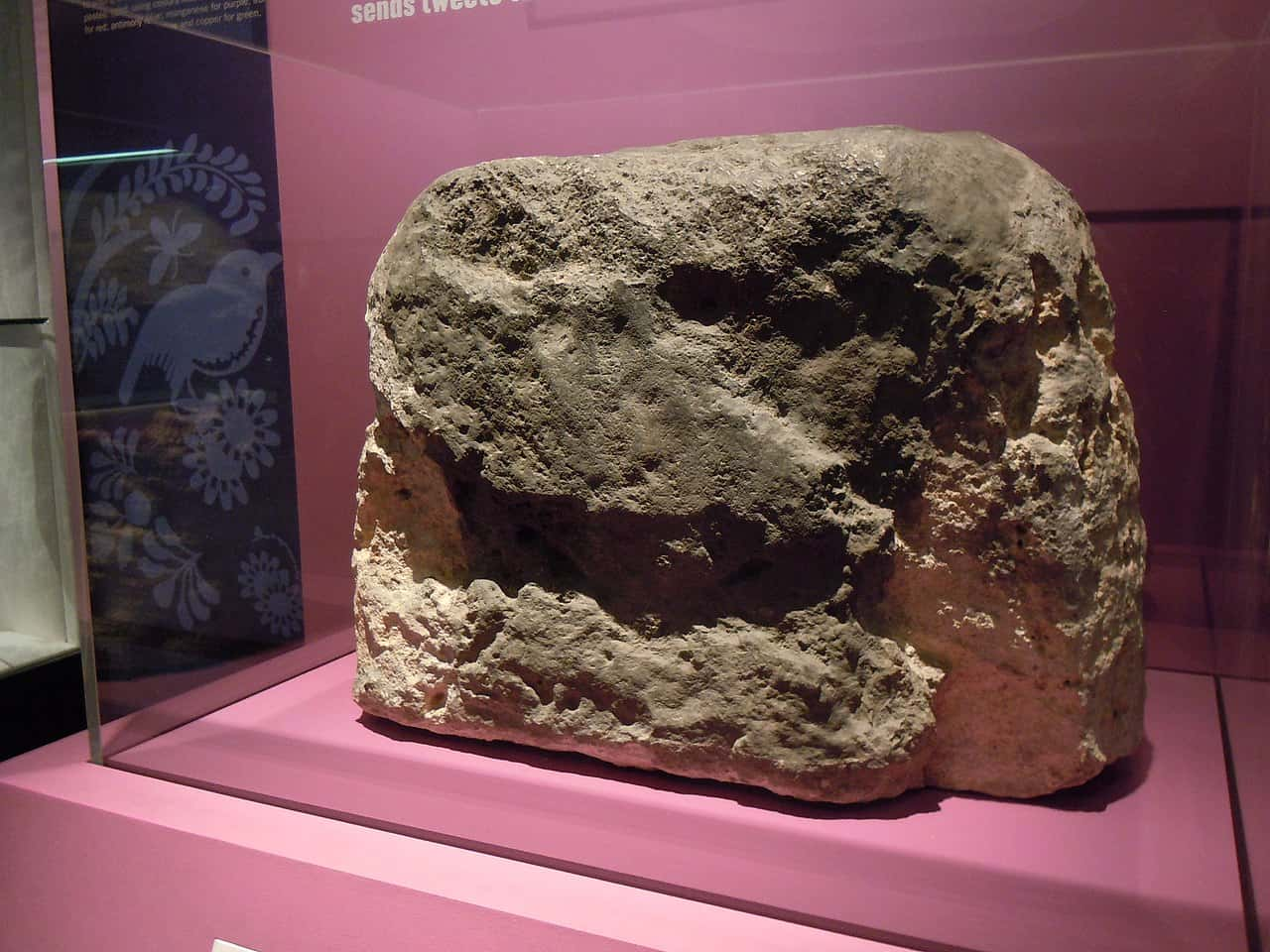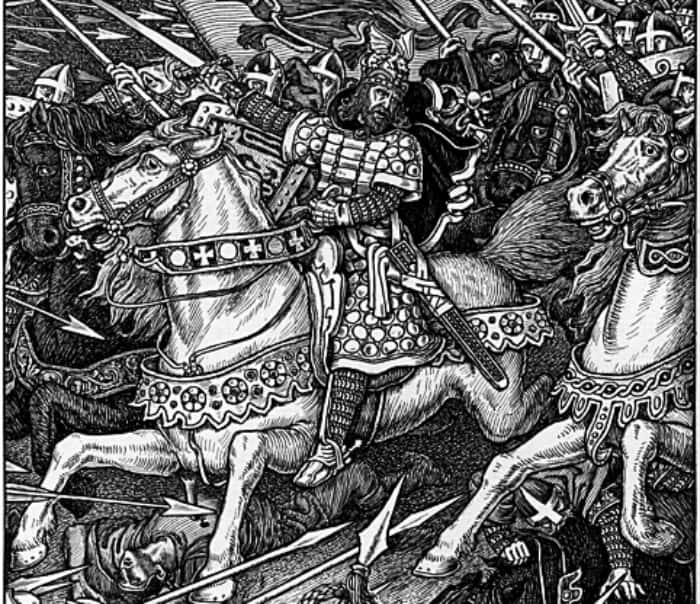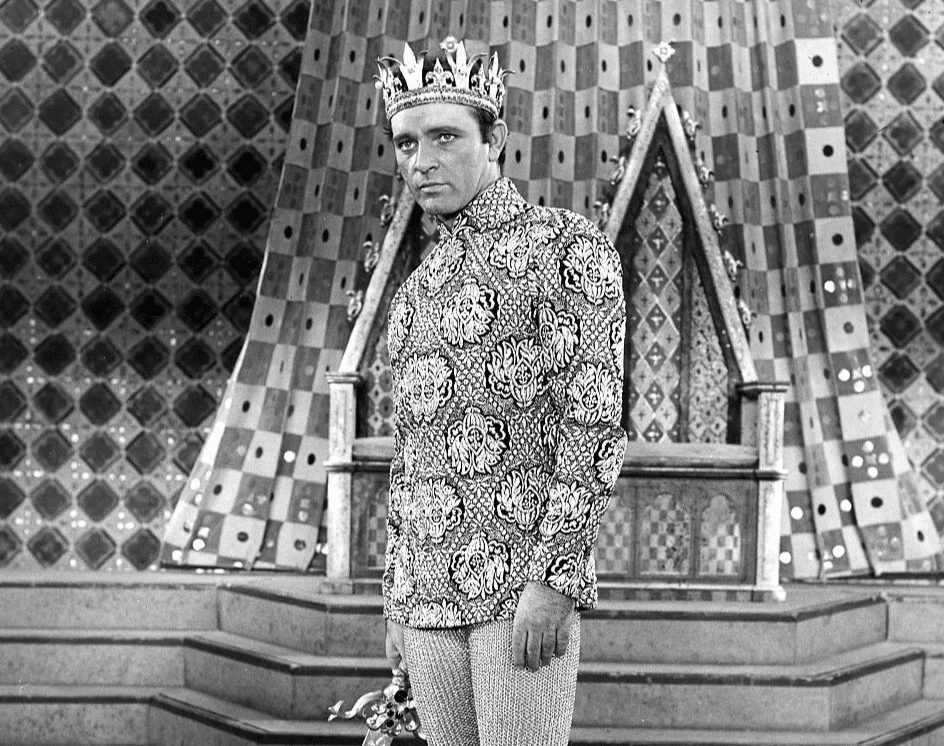"Whoso pulleth out this sword of this stone and anvil, is rightwise king born of all England."— Inscription 7, Le Mort d’Arthur
For centuries, the legendary King Arthur has been immortalized in tales, poems, books, movies, and everything in between—but whether or not he actually existed is a point of contention amongst historians. The period in which he was supposed to have existed has very poor historical records, and almost all known aspects of his life are merely folklore. But... the legend must have come from somewhere, right? Many historians have done some digging and come up with various explanations for the origin of the Arthurian myth. They've also brought forth several candidates for the real, historical King Arthur. Below are 42 facts about the sketchy history behind one of England's greatest legends.
Legend Of King Arthur Facts
40. Riothamus
Some historians believe that the King Arthur from literature may have originated with a real lesser-known figure named Riothamus who lived in post-Roman Britain in the fifth century. Riothamus was military leader who was described with the title of King of the Britons. He is known for crossing the English Channel into Gaul, mirroring events from Arthurian legend as described in Geoffrey of Monmouth's 12th century book History of the Kings of Britain.
39. Great Warrior
Another clue about the origins of Arthur comes from a Welsh poem called Y Gododdin. Dated somewhere between the 7th and 10th centuries, the poem celebrates the British warriors who died in battle at Catraeth in the fifth and sixth centuries, at the height of the Saxon invasion of Britain. It contains what might be the oldest known mention of King Arthur.
38. In Poetry
A poem called Historia Brittonum from around 800 AD, believed to have been the work of a Welsh monk named Nennius, describes Arthur fighting alongside other Briton kings against the Saxons. The poem ends with Arthur’s twelfth battle at Badon Hill. Another poem written about 100 years later also references the Battle of Badon, where Arthur supposedly carried a cross on his shoulders for three days and three nights before emerging victorious. Several other poems, also from the 10th century, make reference to Arthur as well. These poems are some of the earliest records we have of a potential historical King Arthur, and they laid the foundation of the Arthurian myth. Though little is known for sure, it is generally believed that, if nothing else, the Battle of Badon did actually occur between the Britons and invading Anglo-Saxons.
37. Defeating the Saxons
When Roman rule in Britain ended in the early fifth century, the Celtic Britons were vulnerable to attack. According to history, a nobleman named Vertigern brought in Anglo Saxon mercenaries to strengthen their defenses, but they turned on their employers and attempted a takeover of Briton. The invasion attempt was thwarted by an army of Britons who were led by a Briton King who might possibly have been Arthur.
36. Oral History
The legend of King Arthur was likely formed by the passing down of Welsh stories between generations, eventually recorded by Nennius in his Historia Brittonum (The History of the Britons). However, Nennius got his information from the oral tradition, and the time and geographical span of the different battles means it would have been impossible for a single man to fight all of them. So while there could be some fact behind these stories, they certainly can't be taken as the whole truth.
35. Folk Tale
Prior to the first written mention of King Arthur in the ninth century, stories about him would have all been transmitted orally, which makes it incredibly difficult to prove or disprove anything about Arthur’s existence, or to even credit any single, authoritative source. By the time the Historia Brittonum was written, he was already a folk hero, and the legend simply evolved through time. While historians are also careful to note that exaggerated does not mean imaginary, with a lack of firm evidence, it’s hard to separate the truth from the legend.
34. This All Came From A Book, But You Can't Read It
Geoffrey of Monmouth’s 12th century book History of Kings of Britain was the first to write the full life story of Arthur, and was the first to mention Guinevere, Merlin, Lancelot, and of course the famed sword Excalibur (which he called Caliburn). He claimed that the book was based on a lost Celtic manuscript that he alone could study, but its contents are as much myth as they are fact (probably more). Much of what people believe about Arthur stems from this book.
33. Monty Python and the... Pearl Rimmed Caulron?
A popular theme in Arthurian legend was his quest for a holy vessel, but it wasn't always the Holy Grail that he sought. In the story Preiddeu Annwfn, or "Spoils of the Otherworld," Arthur and his warriors sail to the Celtic Otherworld to procure the pearl-rimmed Cauldron of Annwfn. In Medieval times, the vessel morphed into a Holy Grail, and the Knights of the Round Table searched all of Britain for it.
32. Finding Camelot
In the 1960s, archaeologists discovered stone remains of a fortress at Cadbury Hill. The fortress was located on the supposed site of Camelot, and pottery found there matched the correct time period in which Arthur might have lived. The fortress was described as a grand structure belonging to a military leader rather than a king, lending further credence to the theory that Arthur may have been a general, not a monarch.

Sign up to our newsletter.
History’s most fascinating stories and darkest secrets, delivered to your inbox daily. Making distraction rewarding since 2017.
31. Fanning the Myth
Throughout time, English rulers ranging from Henry VIII to Queen Victoria used Arthur’s legend for political purposes. In modern times, writers, filmmakers, painters and photographers have done their part to grow the myth, each putting their own spin on the story. Nobody seems all that concerned with the truth, especially when it gets in the way of a really good story!
30. A French Invention
Though there may have been a King Arthur, and he likely would have had a fortress that he called home, "Camelot" as we know it was actually invented in the 12th century by a French poet named Chrétien de Troyes. Whether the castle ever existed or not, stories about Camelot and the Knights of the Round Table were found in hundreds of manuscripts between the 11th and 15th centuries and exist in dozens of languages.
29. Scottish Chieftain
In 2015, Dr. Andrew Breeze, a professional philologist and Celticist from the University of Navarre in Spain, published a paper claiming that Arthur was not a Roman or a monarch, but was instead a chieftain or a warrior, living and fighting in Scotland. Breeze claimed to have located the actual sites of the battles listed in Nennius’ history, and they were all in Northumberland and southern Scotland. He also claimed that the famous Battle of Badon wasn’t fought by Arthur at all. Breeze continues to adamantly defend his theory, though it has largely been met with skepticism by the greater academic community.
28. Tomb of Arthur
The legend of King Arthur states that after his death, he was transported to the mythical Isle of Avalon. In 2016, new research suggested that he may have been buried a little closer to home—in a field in Shropshire, England. In his book The Lost Tomb of King Arthur, researcher Graham Philips suggested that Arthur’s tomb was most likely outside of the village in an old fort known as “The Berth,” or perhaps at a former chapel nearby. Early exploration uncovered what Philips believed to be Arthur’s shield, no sign of that legendary sword though.
27. Courtly Love
The romantic version of Arthur that exists in legend today was created in a period when, believe it or not, romantic stories were extremely popular. In 15th century England, ideas of chivalry and courtly love were all the rage, and would have been requested by powerful women in the English and French courts. Sir Thomas Malory’s Le Mort d’Arthur was a romantic tale that created the iconic image of Arthur pulling the sword from the stone. So, sadly, while that is an undeniably epic image of the legendary king, it almost certainly has absolutely nothing to do with an historical King Arthur.
26. Room for 1,000
King Arthur’s round table is a central part of his legend, and it may actually have some basis in reality, but according to historians, it wasn’t a table—it was a structure. The "round table" would have been made of wood and stone, and allowed room for 1,000 people to gather around a circular meeting place. The nobles would have been seated in the front row, while lower ranking subjects would have been seated on stone benches around the outside of the circle.
25. Imitating the Table
King Henry III was completely enamoured with the King Arthur legend, and in the later years of the 13th century, he commissioned a replica of the legendary round table. It was constructed from English oak around 1290 AD for a Round Table Festival being held near Winchester, and it actually still exists today, hanging in the Great Hall of Winchester Castle. The tabletop has a diameter of 5.5 meters and weighs 1,200 kg. The table’s artwork dates back to Henry VIII, and the design is believed to portray Henry as King Arthur surrounded by the legendary knights.
24. Sword in the Stone
The myth of the Sword in the Stone originated with the French poet Robert de Boron and his work Merlin from the 12th century (what's with all these French guys writing about a legendary English king?). In his poem, the sword is actually anchored in an anvil, but in later versions of the story, the anvil became a stone. In some texts, Excalibur and the sword in the stone are one and the same, but the Vulgate Cycle and Thomas Malory’s work present them as two different objects.
23. No Mention
One (honestly pretty convincing) argument against the existence of a historical King Arthur is his lack of mention in any of the histories of his time. A history written by the monk and historian Gildas notes a different person as leader of the Britons, and Arthur’s name does not appear in any lists of British Kings. However, there is one reference to an unnamed leader of the Britons which could theoretically be Arthur, so there's still hope!
22. Compilation
One idea that many historians agree upon is that Arthur could have been either an individual or perhaps a combination of several different people. Many of the heroes of the Dark Ages were men to whom storytellers attributed imaginary talents and ranks, and so it’s also possible that Arthur could have been a Celtic hero who had a mythology formed around him.
21. Place of Conception
King Arthur was supposedly conceived at Tintagel Castle, which excavations have proven did actually exist—it was the fortified home of a ruler of Cornwall around 500 AD. The remains of a number of luxury goods were found at the site, as well as a slate with the name “Artognou,” along with other names from the stories, engraved on it. Hey, that's enough for me to believe!
 Wikimedia Commons, Kerry Garratt
Wikimedia Commons, Kerry Garratt
20. Saint Arthur
One often overlooked aspect of Arthur’s legend is his presence in hagiographies, which are writings about the lives of Saints. For a time, their writers frequently used King Arthur’s legend to give their own characters credibility and to make them more relatable. The stories don’t prove that Arthur existed, but they demonstrate just how strongly people of the time believed that he was a real figure, and an extremely important one at that.
 Wikimedia Commons, Robin Drayton
Wikimedia Commons, Robin Drayton
19. An Ancient Practice
Swords, especially magical ones, have an important place in mythology, and are associated with legendary figures and kings throughout the world. The story of Excalibur and the Lady of the Lake may have derived from the ancient Celtic practice of placing weaponry, swords and other valuables in sacred lakes and rivers. The Thames River in particular seems to have been a popular location for such rituals, and the Battersea Shield and Waterloo Helmet were both uncovered there.
18. Back in Fashion
During the Victorian Age, the stories of King Arthur morphed yet again, and they experienced a resurgence of popularity in a time of rapid and significant change. Queen Victoria chose themes from the Malory version of the Arthurian legend to decorate her robing room in the newly rebuilt Parliament buildings. At the same time, new romantic poems about Arthur by Tennyson and Morris became popular, as did recreations of Arthurian legend in painting and photography.
17. Everyone's Got an Idea
Most people believe that Merlin is a completely made up character in the King Arthur cannon, but while magical wizards don’t exist (... that we know of), there actually seems to be more historical basis for Merlin than for almost anyone else of Arthurian legend. English author Nikolai Tolstoy believes that Merlin may have been based on a 6th century Welsh or Scottish druid, while other historians believe that he may have been based on a pagan figure from pre-Dark Ages England, or perhaps even an early Scottish Christian.
16. Lancel-NOT
Lancelot, Arthur’s trusted Knight of the Round Table, was not present in the first King Arthur tales, and isn’t even mentioned until the works of Chrétien de Troyes in the 12th century. Though there are several mentions of a figure named Lancelot in historical documents, it’s still likely that Troyes just made the Arthurian Lancelot up.
15. King Arthur the Heretic
In some stories, King Arthur is portrayed as a follower of the monk Pelagius, who taught that human beings were free and responsible for their own redemption (an incredibly heretical idea at the time). Pelgagius is featured Jack Whyte’s science-fiction/fantasy books which build on the Arthur legend, and he was also a character in the 2004 action/adventure movie King Arthur. Although Pelagius did exist, none of the Arthurian texts even suggest that Arthur followed him, which mean that while it's perhaps an interesting story, Arthur was very likely not a Pelagian Christian, as has been portrayed.
 King Arthur (2004), Touchstone Pictures
King Arthur (2004), Touchstone Pictures
14. Naming a King
In the famous legend about the Sword in the Stone, King Arthur draws a sword from the stone and is thus proclaimed the rightful King of England. Robert de Boron’s 13th century epic poem Merlin is the first time the sword is mentioned as part of the Arthur story, but it’s possible that it came from another legend about an artifact called “The London Stone.” Today, the legend goes that it was the stone from which Arthur pulled his sword, but it was likely originally part of a myth that a King would strike the stone with his sword to establish his right to rule. Regardless of its true history, you can actually go see the London Stone today, if you really felt like it—it's kept at 111 Cannon Street in the City of London (though it's currently at the Museum of London while its usual home is undergoing renovations). Go check it out!
 Wikimedia Commons, Lord Belbury
Wikimedia Commons, Lord Belbury
13. #RoundTableSoWhite
In most on-screen portrayals, the Knights of the Round Table are all white, but they were actually quite the diverse bunch in early writings. The Knights were described as “moorish”—people of African or Middle-Eastern descent. In a Smithsonian article on the subject, a knight named Moren is described as being black. Several other members of King Arthur’s court were also described as being of Arabic descent, suggesting that the way you probably picture the round table might not be accurate, even to the myths themselves.
12. I Like to Push the Pramalot
Early histories about King Arthur don’t make reference to Camelot, and even assuming that Arthur existed, it’s very possible that he didn't live there. The first account of the castle appears in the Geoffrey of Monmouth Historia Regum Britanniae, but according to the University of Rochester’s Camelot Project, Arthur didn’t become connected to the castle until the Troyes poems decades later (there's ol' Troyes again!). In Monmouth’s stories, Arthur ruled from the Welsh City Caerleon, and Camelot was simply part of his territory. In the Troyes poems, which also introduced the Holy Grail, Camelot took the form that is best-known today.
11. Mistranslation
Another theory about the sword in the stone myth is that the stories were simply mistranslated from Latin. The latin word for stone is saxum, and it’s possible that the stories were referring to Arthur as the sword in the Saxon, and the words simply got confused in translation. Makes sense to me.
10. Origins of Excalibur
Just like much of Arthur’s history, Excalibur is also believed to have Welsh roots. Caliburnus, as it’s referred to in Monmouth’s stories, is derived from Caledfwich—a magical sword that is present in several Celtic myths. Caliburnus eventually became Escalibor, and then the current Excalibur.
9. Celtic Water Goddess
In Arthurian legend, the Lady of the Lake presents Arthur with the sword Excalibur, and but the myths surrounding her precede Arthur. It’s possible that she was a derivative of the Celtic Water Goeddess Coventina—she is often called "Vi-vianna," which likely comes from "Co-Vianna," a variant of Coventina. The Lady is also referred to as Nimue, which could be a reference to Mnemosyne—one of nine water-nymph muses who gave weapons to Perseus in Greek and Roman mythology.
8. One and the Same
According to the stories, King Arthur met his end at the Battle of Camlann, fighting against Mordred, and there is some evidence that this battle (or one similar) actually took place. In the chronicle known as the Annals of Wales, Mordred is noted to be the son of Lot, King of the Picts, which would, in turn, make Mordred himself a Pict. The Picts and the Britons did in fact fight each other in battle once, and that battle was fought by Briton named Artur, son of Aidan. Other records give it different names, but according to David Carroll, author of Arturius: A Quest for Camelot, the Battle of Camlann was based on this actual battle, and he believes this to be strong proof of a historical Arthur.
7. Treated Differently
One of the reasons that there's so much murkiness as to whether or not Arthur ever existed is the difference in how history was treated in the Early Middle Ages. Yes, some true events would have been recorded in the period, but many were exaggerations or embellishments, if not absolute fiction, used to suit the motives of the author. In the case of Arthur, whether he existed or not, the different accounts of Arthur’s life are more usefully seen as a reflection on the their time and on whoever wrote them.
6. Pre-Middle Ages
Though most of the stories that are told about King Arthur and his knights were transmitted in the Middle Ages, if Arthur truly lived in the fifth or sixth centuries as believed, he lived deep in the era known as the Dark Ages. This was a time when urban life was disappearing and warfare was pretty much constant. Historians named it the Dark Ages because of the arrival of the “barbarian” people into the Western world, but it's now considered to be a derogatory term referring to the fact that knowledge and intellectualism was lost after the Roman era, a statement that is only partly true.
5. No New Arthurs
Considering the importance of King Arthur to English history, it may be surprising to learn that there have been no British kings named Arthur in recorded history. Both Prince Charles and Prince William have Arthur as one of their middle names, but that’s as far as they go. According to Christopher Snyder, dean and professor of history at Mississippi State University and author of The World of King Arthur, the majority of Prince Arthurs have died young, and it's considered a bad omen to outright name a direct heir Arthur.
4. Establishing Ties
In 1233 AD, Richard of Cornwall, the younger brother of King Henry III, traded three of his manors for a small piece of land on the Island of Tintagel. He wanted the land because of the King Arthur’s ties to the area as referenced in Geoffrey of Montmouth’s book. It has long been believed that Richard built a castle there to associate himself with the powerful legend, and maybe it worked? At one point, he was one of the wealthiest men in Europe.
3. Centurion
King Arthur has also been linked to the Roman Centurion named Lucius Artorius Castus, who fought against the Picts, a northern tribe of Scots, in the second century. Castus was a fierce and competent military commander, and several sources note the immense number of men he led into battle. This theory is less credible however, as Artorius' battles took place 300 years before Arthur is believed to have existed. Still, it may have been a seed that fed into the myth.
2. Here Lies Arthur
In 1191 AD, the body of King Arthur was supposedly uncovered by the Monks of Glastonbury Abbey, along with the bones of his wife and a lock of her hair. The man had suffered multiple head wounds, before the final fatal blow. In 1962, Ralegh Radford uncovered the site, showing how the tombs had been disturbed. On display was an ancient lead cross found at the site that was inscribed with the words: “Here lies buried the famous king Arthur with Guinevere his second wife, in the Isle of Avalon.” Sadly, today both the cross and the bones have been lost.
1. Inspired Connection
As much as Lancelot himself might be fiction, Dr. Thomas Asbridge of Queen Mary University in London believes that the Lancelot/Arthur friendship was inspired by the friendship that existed between King Henry the Young and his mentor Sir William Marshal. In that story, Marshal allegedly had an affair with Henry’s wife Queen Margaret (whom the King then certainly sent to a far away court), and it could have been transferred to King Arthur’s history. Marshal's possible adulterous affair with Henry's Queen, however, was not his only sin: King Henry's once-loyal companion was also disgraced because of his own arrogance and greed, and he had violently offended his Majesty on several occasions.
Sources: 1, 2, 3, 4, 5, 6, 7, 8, 9, 10, 11, 12, 13, 14, 15, 16, 17, 18, 19, 20, 21, 22, 23, 24, 25, 26, 27, 28, 29, 30, 31














































